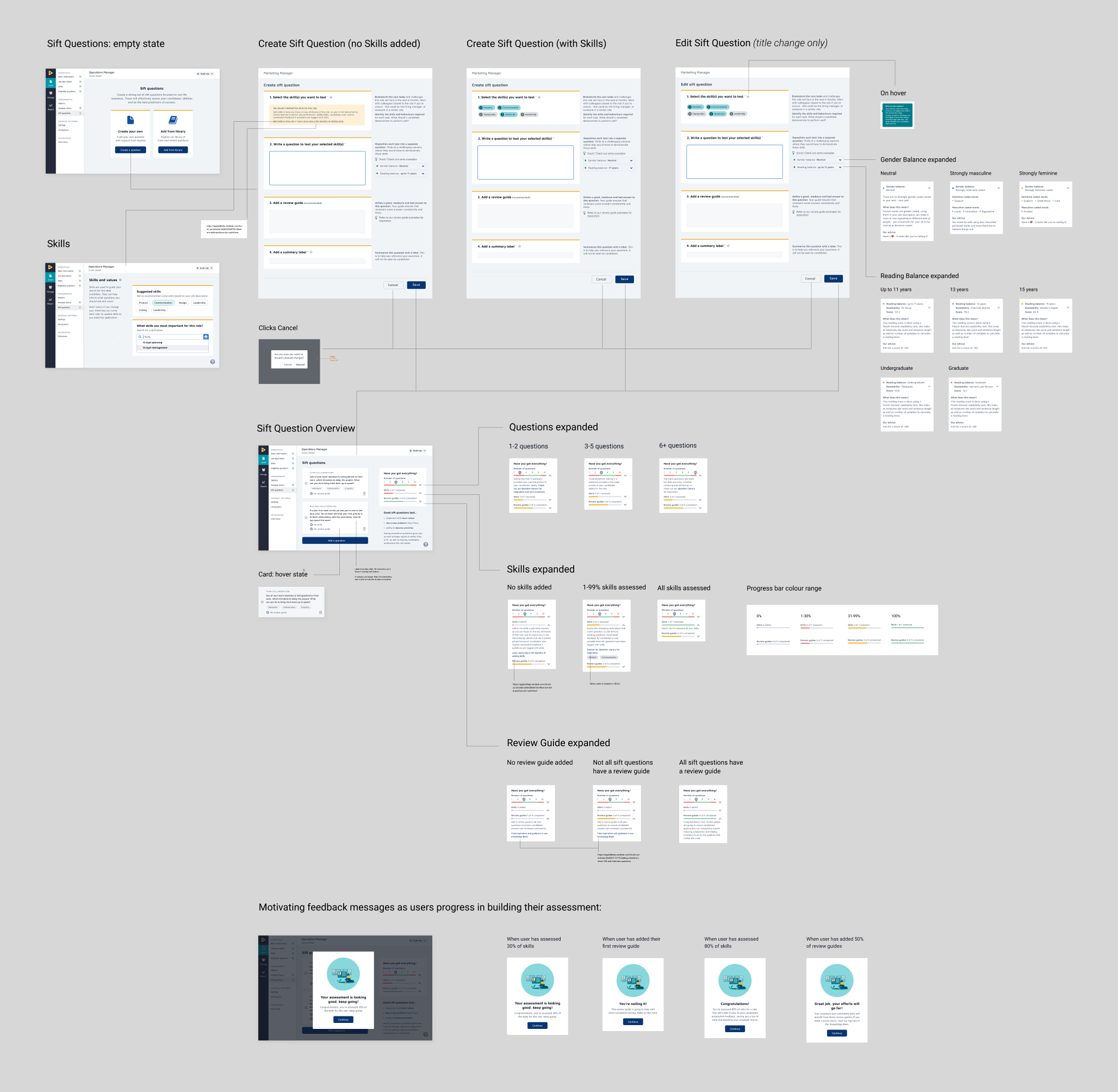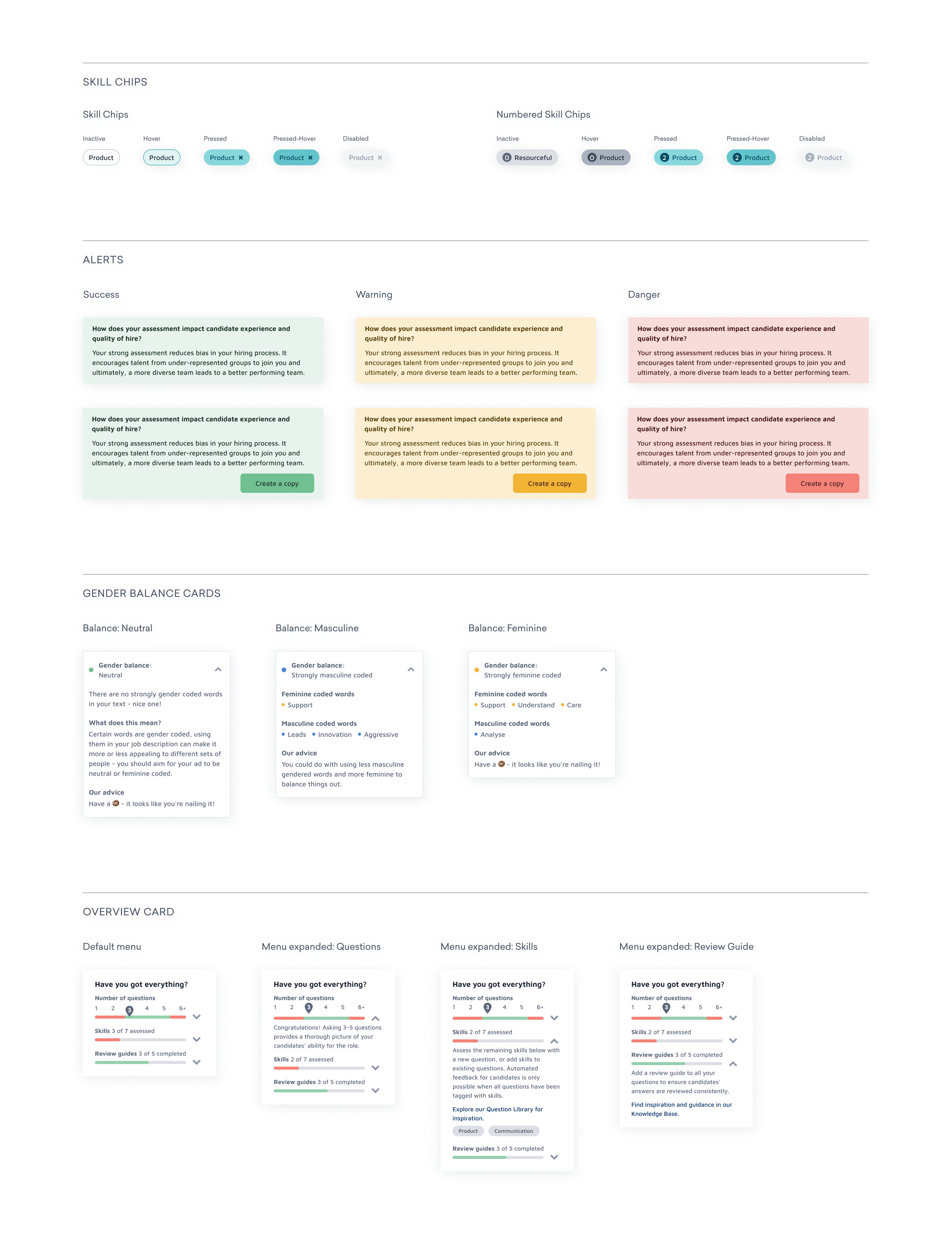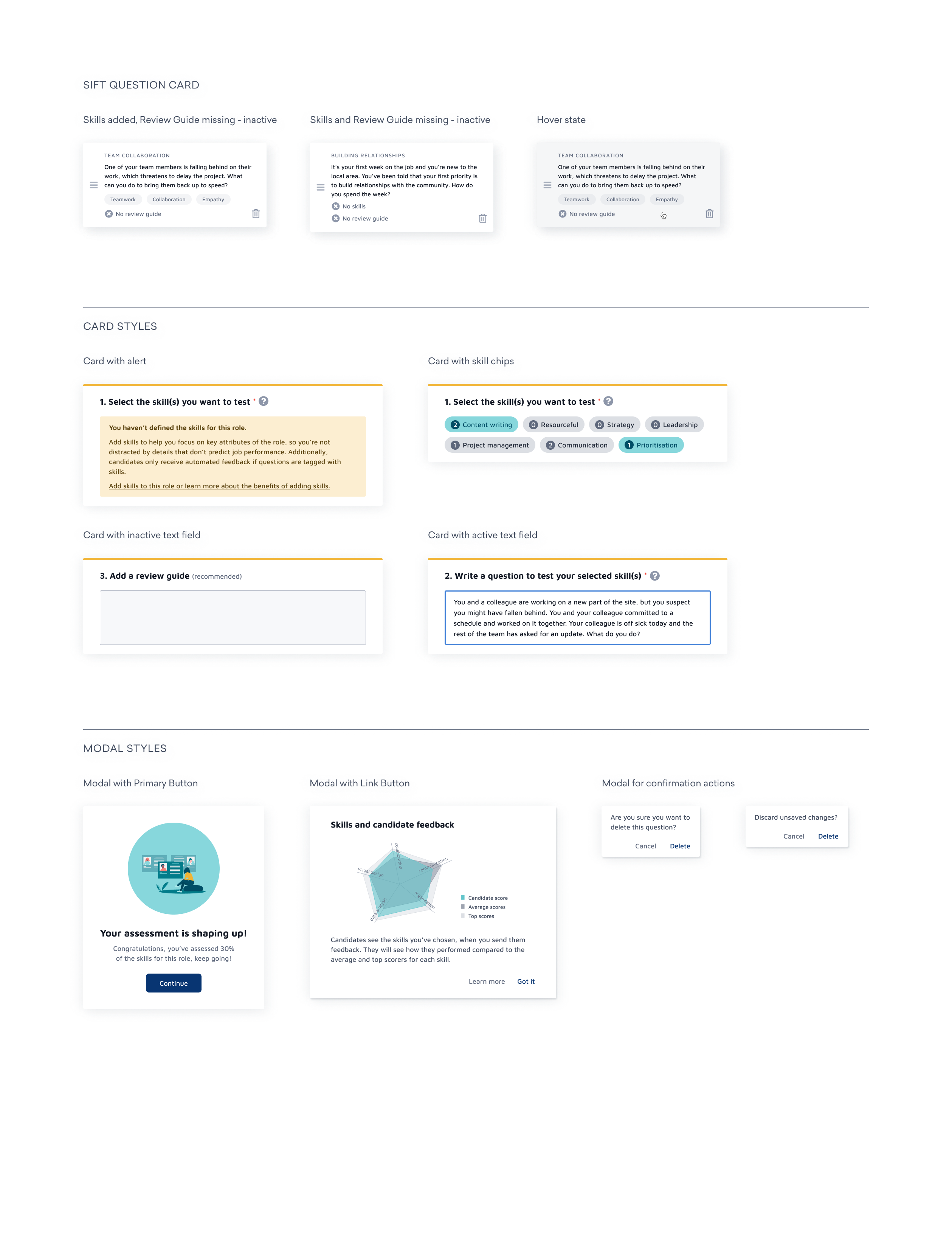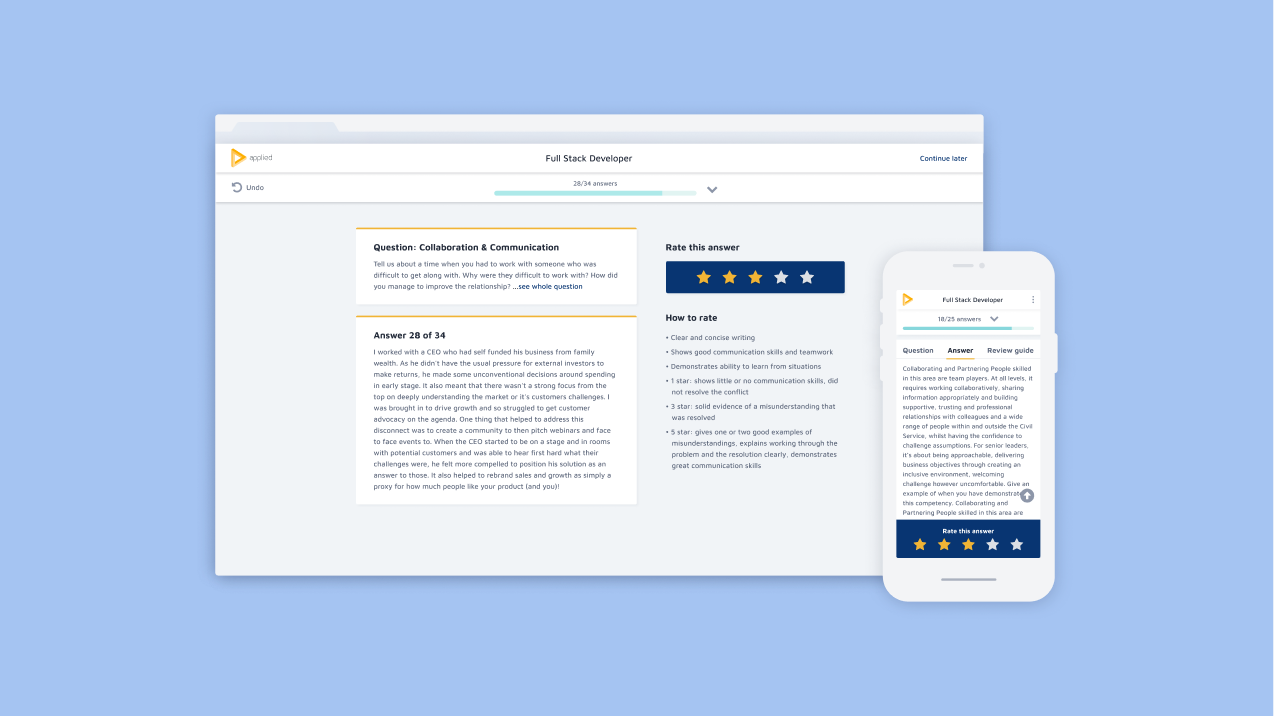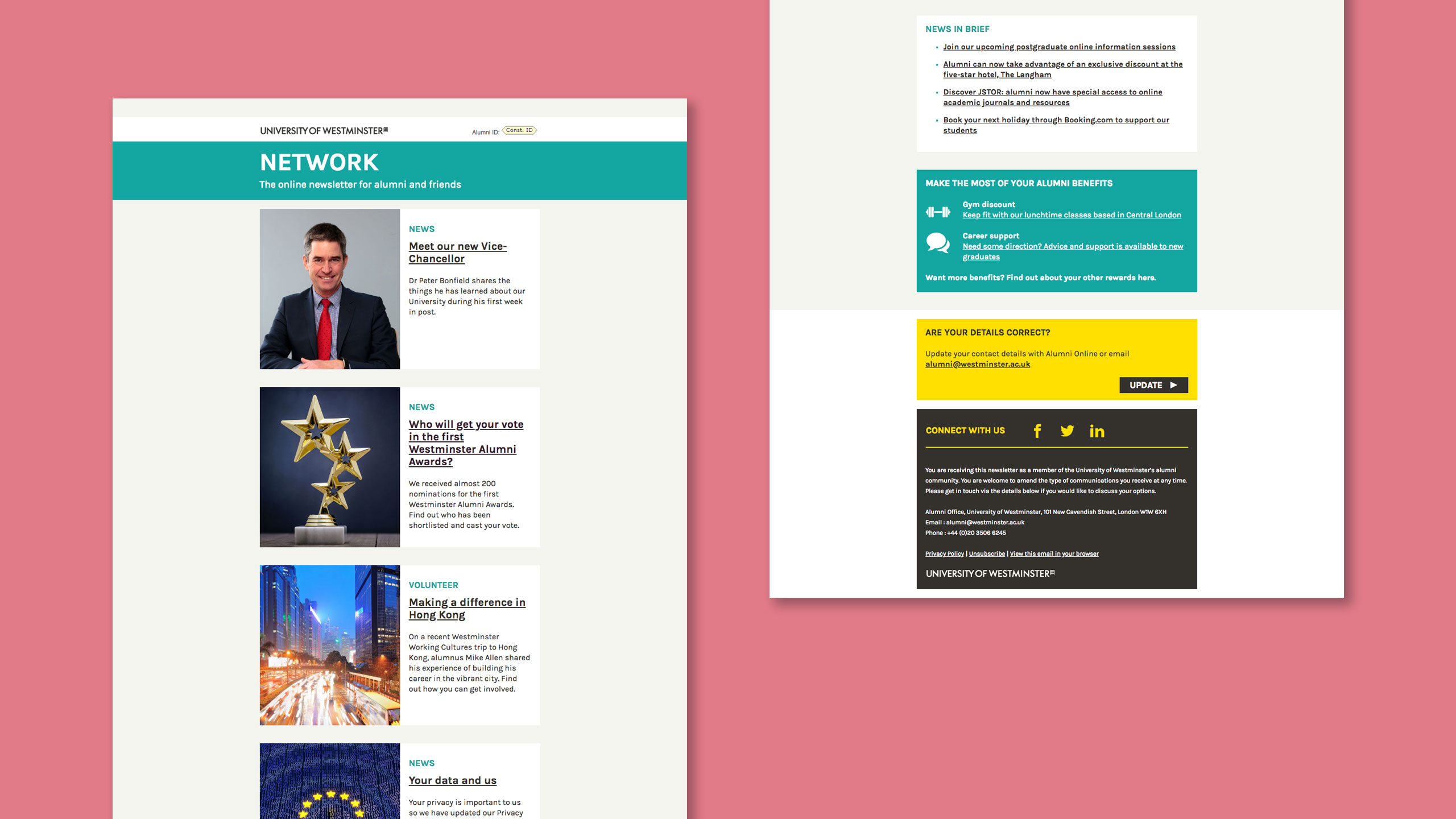Making fair hiring easy
Making fair hiring easy
Making fair hiring easy
Making fair hiring easy
Making fair hiring easy
SUMMARY
SUMMARY
SUMMARY
SUMMARY
SUMMARY
I led the redesign to build structure and clarity into Applied's core assessment method, creating support for users incorporating sift questions into their hiring practice.
I led the redesign to build structure and clarity into Applied's core assessment method, creating support for users incorporating sift questions into their hiring practice.
I led the redesign to build structure and clarity into Applied's core assessment method, creating support for users incorporating sift questions into their hiring practice.
I led the redesign to build structure and clarity into Applied's core assessment method, creating support for users incorporating sift questions into their hiring practice.
I led the redesign to build structure and clarity into Applied's core assessment method, creating support for users incorporating sift questions into their hiring practice.
OUTCOMES
OUTCOMES
OUTCOMES
OUTCOMES
OUTCOMES
Using a combination of remote user research and group ideation sessions, our MVP solution has increased better assessment practice by 6 - 12% across different customer cohorts.
Using a combination of remote user research and group ideation sessions, our MVP solution has increased better assessment practice by 6 - 12% across different customer cohorts.
Using a combination of remote user research and group ideation sessions, our MVP solution has increased better assessment practice by 6 - 12% across different customer cohorts.
Using a combination of remote user research and group ideation sessions, our MVP solution has increased better assessment practice by 6 - 12% across different customer cohorts.
Using a combination of remote user research and group ideation sessions, our MVP solution has increased better assessment practice by 6 - 12% across different customer cohorts.
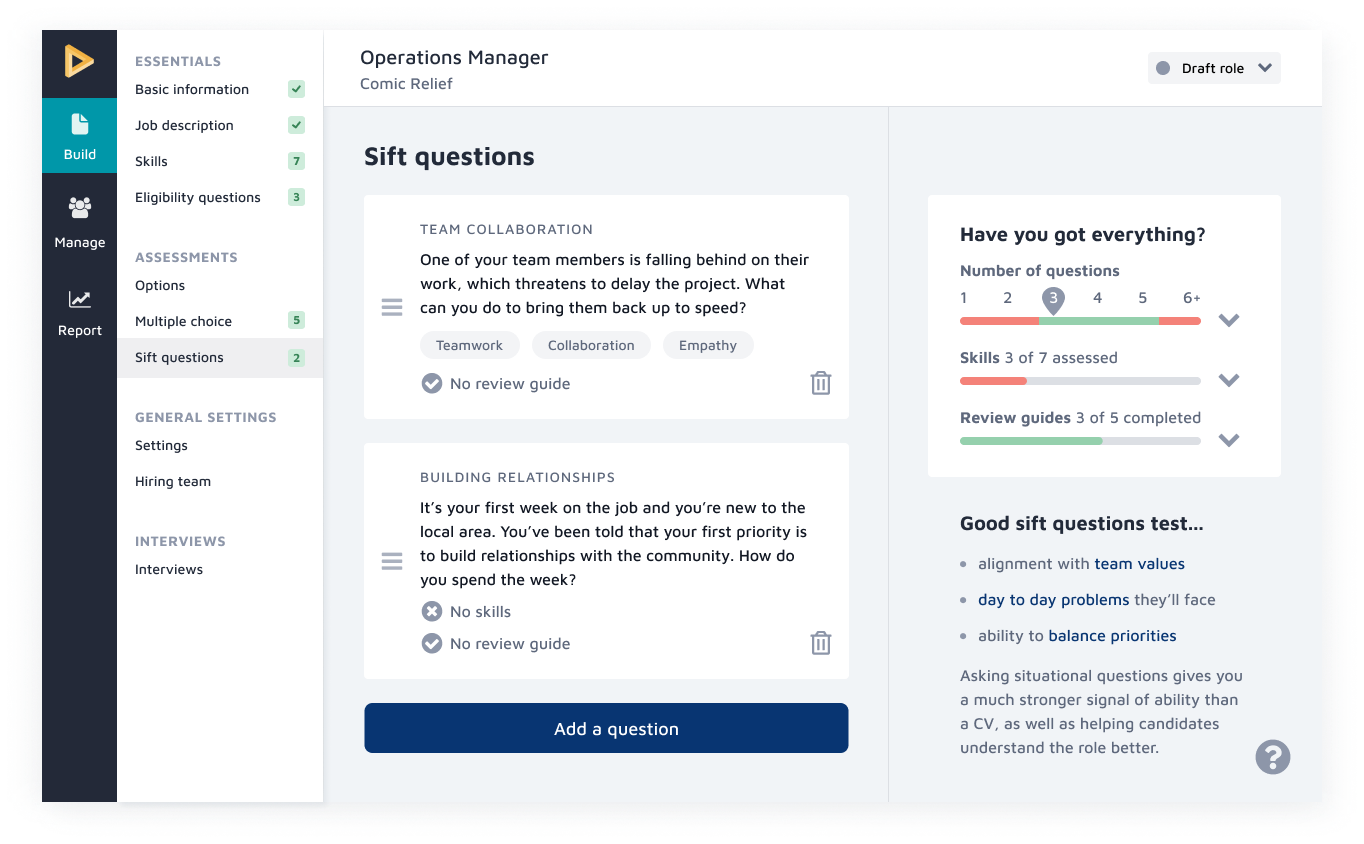
What is Applied?
What is Applied?
What is Applied?
What is Applied?
What is Applied?
Applied helps organisations hire more effectively and fairly using sift questions. Backed by behavioural science, the sift process is a vital step in the hiring process that replaces CVs with work sample questions.
Applied helps organisations hire more effectively and fairly using sift questions. Backed by behavioural science, the sift process is a vital step in the hiring process that replaces CVs with work sample sift questions.
Applied helps organisations hire more effectively and fairly using sift questions. Backed by behavioural science, the sift process is a vital step in the hiring process that replaces CVs with work sample sift questions.
Applied helps organisations hire more effectively and fairly using sift questions. Backed by behavioural science, the sift process is a vital step in the hiring process that replaces CVs with work sample sift questions.
Applied helps organisations hire more effectively and fairly using sift questions. Backed by behavioural science, the sift process is a vital step in the hiring process that replaces CVs with work sample sift questions.
The challenge
The challenge
The challenge
The challenge
The challenge
Through feedback sessions with our Customer Success team, we had observed that our users were struggling to write sift questions that effectively and fairly assessed their candidates. Users were expected to replace the familiarity of CVs with a new hiring method without providing them with any support in-app.
Through feedback sessions with our Customer Success team, we had observed that our users were struggling to write sift questions that effectively and fairly assessed their candidates. Users were expected to replace the familiarity of CVs with a new hiring method without providing them with any support in-app.
Through feedback sessions with our Customer Success team, we had observed that our users were struggling to write sift questions that effectively and fairly assessed their candidates. Users were expected to replace the familiarity of CVs with a new hiring method without providing them with any support in-app.
Through feedback sessions with our Customer Success team, we had observed that our users were struggling to write sift questions that effectively and fairly assessed their candidates. Users were expected to replace the familiarity of CVs with a new hiring method without providing them with any support in-app.
Through feedback sessions with our Customer Success team, we had observed that our users were struggling to write sift questions that effectively and fairly assessed their candidates. Users were expected to replace the familiarity of CVs with a new hiring method without providing them with any support in-app.
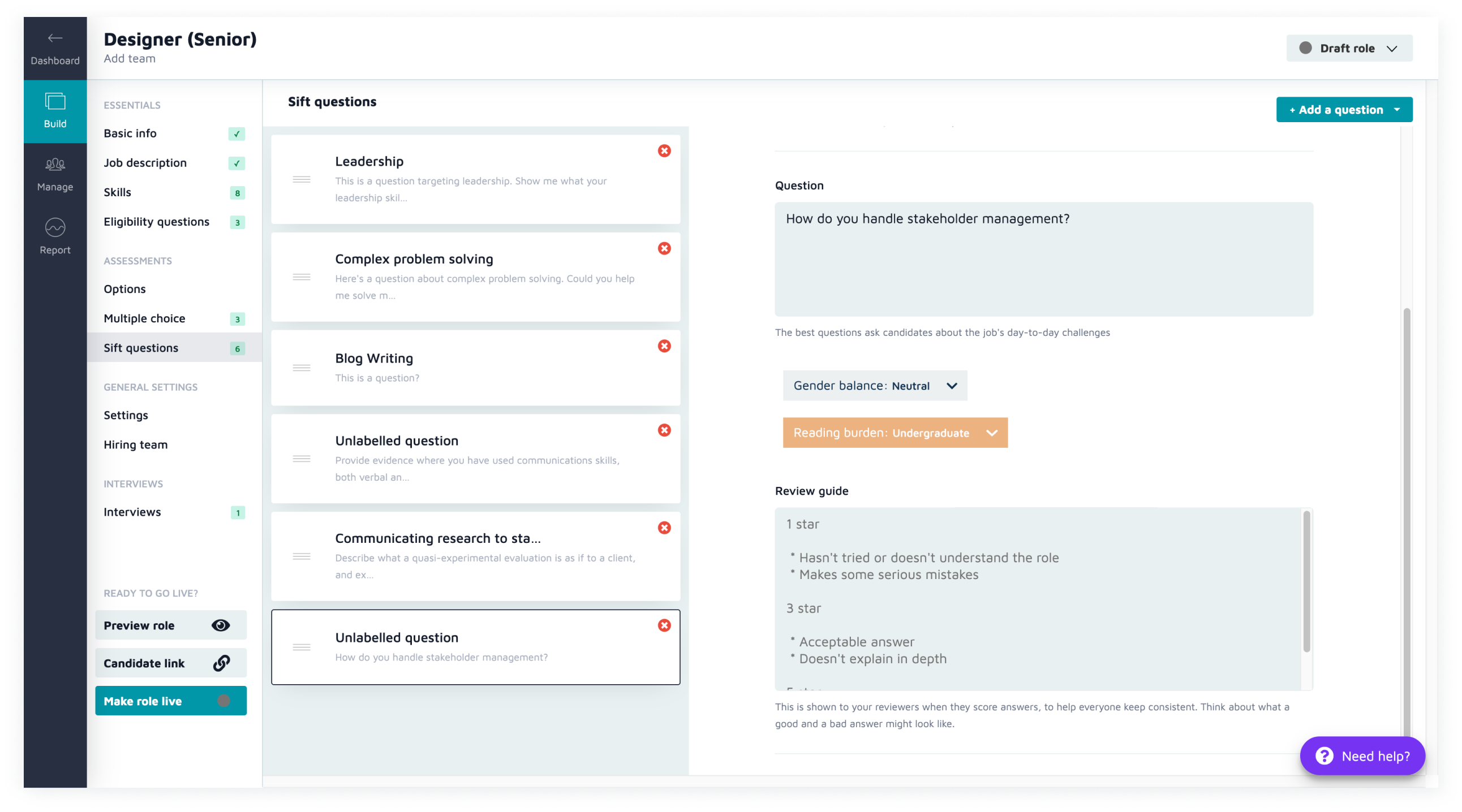
The old design was visually cluttered with a layout that did not conform to users' mental models, and overly emphasised low priority CTAs e.g. delete buttons.
The old design was visually cluttered with a layout that did not conform to users' mental models, and overly emphasised low priority CTAs e.g. delete buttons.
Hurting the business bottom line
Hurting the business bottom line
Hurting the business bottom line
Hurting the business bottom line
Hurting the business bottom line
The Research team identified that incorrect use of the platform was linked to churning customers. Sift questions without skills and review guides attached were big indicators, affecting our customers' hiring experience and success of finding the right talent.
The Research team identified that incorrect use of the platform was linked to churning customers. Sift questions without skills and review guides attached were big indicators, affecting our customers' hiring experience and success of finding the right talent.
The Research team identified that incorrect use of the platform was linked to churning customers. Sift questions without skills and review guides attached were big indicators, affecting our customers' hiring experience and success of finding the right talent.
The Research team identified that incorrect use of the platform was linked to churning customers. Sift questions without skills and review guides attached were big indicators, affecting our customers' hiring experience and success of finding the right talent.
The Research team identified that incorrect use of the platform was linked to churning customers. Sift questions without skills and review guides attached were big indicators, affecting our customers' hiring experience and success of finding the right talent.
My role
My role
My role
My role
My role
Working agile with a focus on speed to market, we had to release an MVP within 3 months, my task was to:
- discover and define users' pain points through research interviews;
- collaborate and ideate with stakeholders to uncover MVP solutions;
- design solutions and conduct usability tests to ensure effectiveness.
Working agile with a focus on speed to market, we had to release an MVP within 3 months, my task was to:
- discover and define users' pain points through research interviews;
- collaborate and ideate with stakeholders to uncover MVP solutions;
- design solutions and conduct usability tests to ensure effectiveness.
Working agile with a focus on speed to market, we had to release an MVP within 3 months, my task was to:
- discover and define users' pain points through research interviews;
- collaborate and ideate with stakeholders to uncover MVP solutions;
- design solutions and conduct usability tests to ensure effectiveness.
Working agile with a focus on speed to market, we had to release an MVP within 3 months, my task was to:
- discover and define users' pain points through research interviews;
- collaborate and ideate with stakeholders to uncover MVP solutions;
- design solutions and conduct usability tests to ensure effectiveness.
Working agile with a focus on speed to market, we had to release an MVP within 3 months, my task was to:
- discover and define users' pain points through research interviews;
- collaborate and ideate with stakeholders to uncover MVP solutions;
- design solutions and conduct usability tests to ensure effectiveness.
The approach
The approach
The approach
The approach
The approach
Due to time constraints, we opted for a lean UX approach, emphasising just enough research, ideating collaboratively, and rapid sketching and prototyping to validate designs internally and test externally. We re-used existing components to save on build time and develop consistency.
Due to time constraints, we opted for a lean UX approach, emphasising just enough research, ideating collaboratively, and rapid sketching and prototyping to validate designs internally and test externally. We re-used existing components to save on build time and develop consistency.
Due to time constraints, we opted for a lean UX approach, emphasising just enough research, ideating collaboratively, and rapid sketching and prototyping to validate designs internally and test externally. We re-used existing components to save on build time and develop consistency.
Due to time constraints, we opted for a lean UX approach, emphasising just enough research, ideating collaboratively, and rapid sketching and prototyping to validate designs internally and test externally. We re-used existing components to save on build time and develop consistency.
Due to time constraints, we opted for a lean UX approach, emphasising just enough research, ideating collaboratively, and rapid sketching and prototyping to validate designs internally and test externally. We re-used existing components to save on build time and develop consistency.
The discovery
The discovery
The discovery
The discovery
The discovery
We worked with the Customer Success team to identify core users struggling with this problem. We mapped them against previously defined proto-personas and recruited users based on behavioural variables covering hiring experience, affinity with CVs and interactions with HR.
I conducted several remote user interviews to uncover the different facets that contributed to their struggle of writing sift questions.
We worked with the Customer Success team to identify core users struggling with this problem. We mapped them against previously defined proto-personas and recruited users based on behavioural variables covering hiring experience, affinity with CVs and interactions with HR.
I conducted several remote user interviews to uncover the different facets that contributed to their struggle of writing sift questions.
We worked with the Customer Success team to identify core users struggling with this problem. We mapped them against previously defined proto-personas and recruited users based on behavioural variables covering hiring experience, affinity with CVs and interactions with HR.
I conducted several remote user interviews to uncover the different facets that contributed to their struggle of writing sift questions.
We worked with the Customer Success team to identify core users struggling with this problem. We mapped them against previously defined proto-personas and recruited users based on behavioural variables covering hiring experience, affinity with CVs and interactions with HR.
I conducted several remote user interviews to uncover the different facets that contributed to their struggle of writing sift questions.
We worked with the Customer Success team to identify core users struggling with this problem. We mapped them against previously defined proto-personas and recruited users based on behavioural variables covering hiring experience, affinity with CVs and interactions with HR.
I conducted several remote user interviews to uncover the different facets that contributed to their struggle of writing sift questions.
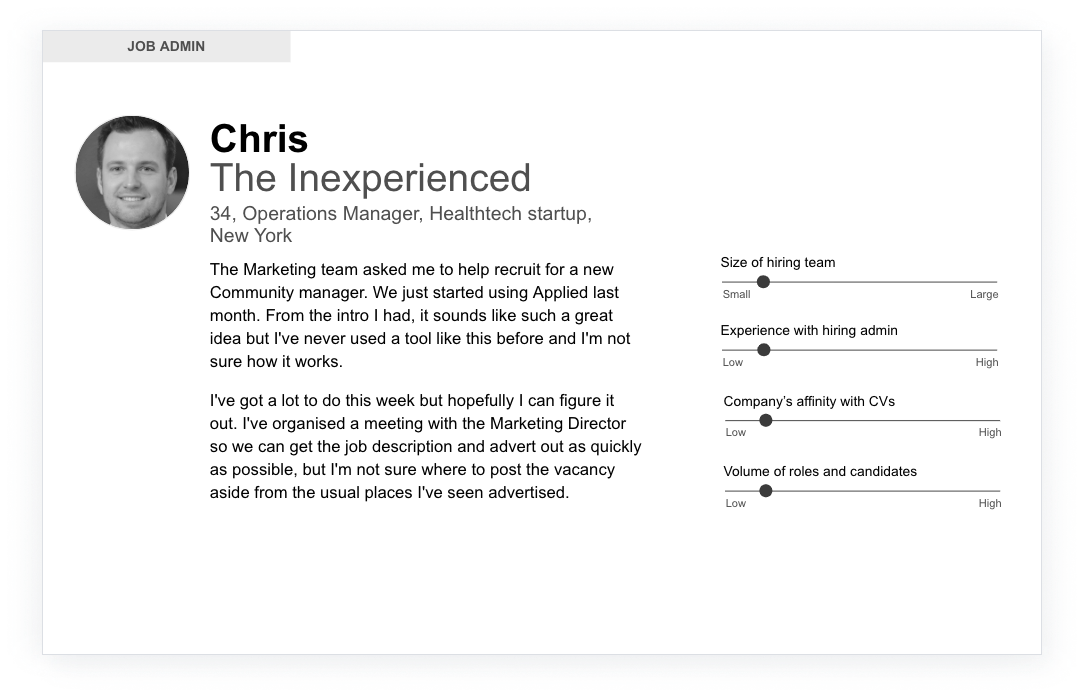

Our target user groups had the role of a Hiring Manager looking to hire someone new for their team, or a Job Admin within an HR function.
Our target user groups had the role of a Hiring Manager looking to hire someone new for their team, or a Job Admin within an HR function.
Research insights
Research insights
Research insights
Research insights
Research insights
Collaboration happens off-app
Collaboration happens off-app
Collaboration happens off-app
Collaboration happens off-app
Collaboration happens off-app
In some larger organisations, Hiring Managers do not interact with Applied. Instead, they use Google Docs to draft questions with colleagues.
In some larger organisations, Hiring Managers do not interact with Applied. Instead, they use Google Docs to draft questions with colleagues.
In some larger organisations, Hiring Managers do not interact with Applied. Instead, they use Google Docs to draft questions with colleagues.
In some larger organisations, Hiring Managers do not interact with Applied. Instead, they use Google Docs to draft questions with colleagues.
In some larger organisations, Hiring Managers do not interact with Applied. Instead, they use Google Docs to draft questions with colleagues.
Clearer assessment standards required
Clearer assessment standards required
Clearer assessment standards required
Clearer assessment standards required
Clearer assessment standards required
Job Admins and Hiring Managers want more structure to help write sift questions. They want company consistency to ensure fair hiring takes place across the board.
Job Admins and Hiring Managers want more structure to help write sift questions. They want company consistency to ensure fair hiring takes place across the board.
Job Admins and Hiring Managers want more structure to help write sift questions. They want company consistency to ensure fair hiring takes place across the board.
Job Admins and Hiring Managers want more structure to help write sift questions. They want company consistency to ensure fair hiring takes place across the board.
Job Admins and Hiring Managers want more structure to help write sift questions. They want company consistency to ensure fair hiring takes place across the board.
More examples needed
More examples needed
More examples needed
More examples needed
More examples needed
Users want guidance on what types of questions to ask, and more examples of what a good question entails.
Users want guidance on what types of questions to ask, and more examples of what a good question entails.
Users want guidance on what types of questions to ask, and more examples of what a good question entails.
Users want guidance on what types of questions to ask, and more examples of what a good question entails.
Users want guidance on what types of questions to ask, and more examples of what a good question entails.
Time pressure
Time pressure
Time pressure
Time pressure
Time pressure
Users struggle to find time to create good sift questions that meaningfully assesses what they are looking for.
Users struggle to find time to create good sift questions that meaningfully assesses what they are looking for.
Users struggle to find time to create good sift questions that meaningfully assesses what they are looking for.
Users struggle to find time to create good sift questions that meaningfully assesses what they are looking for.
Users struggle to find time to create good sift questions that meaningfully assesses what they are looking for.
"We haven't decided on a consistent approach to sift question writing - but I would really like a lot more structure."
"We haven't decided on a consistent approach to sift question writing - but I would really like a lot more structure."
"We haven't decided on a consistent approach to sift question writing - but I would really like a lot more structure."
"We haven't decided on a consistent approach to sift question writing - but I would really like a lot more structure."
— User research participant
Diverging and converging with stakeholders
Diverging and converging with stakeholders
Diverging and converging with stakeholders
Diverging and converging with stakeholders
Diverging and converging with stakeholders
Working with the Product Manager we synthesised the insights from our research to define a problem statement we could align ourselves with:
Working with the Product Manager we synthesised the insights from our research to define a problem statement we could align ourselves with:
Working with the Product Manager we synthesised the insights from our research to define a problem statement we could align ourselves with:
I sketched wireframes and ran a number of design crits with Product, Tech and Customer Success teams, making iterations following their feedback.
I sketched wireframes and ran a number of design crits with Product, Tech and Customer Success teams, making iterations following their feedback.
"How might we improve the sift question writing process so that our users are able to write sift questions more quickly, whilst feeling confident with the quality of their questions, and the data they use to shortlist candidates?"
"How might we improve the sift question writing process so that our users are able to write sift questions more quickly, whilst feeling confident with the quality of their questions, and the data they are shortlisting candidates on?"
"How might we improve the sift question writing process so that our users are able to write sift questions more quickly, whilst feeling confident with the quality of their questions, and the data they are shortlisting candidates on?"
"How might we improve the sift question writing process so that our users are able to write sift questions more quickly, whilst feeling confident with the quality of their questions, and the data they are shortlisting candidates on?"
Presenting these insights, I led an ideation session with stakeholders who had interacted with users across the conversion funnel and could offer unique perspectives. We generated ideas independently and converged to discuss potential solutions, dot voting on the biggest impact ideas.
Working with the Product Manager, we assessed ideas against our appetite for build times. With a three month deadline to research, design, test and build a solution, we prioritised MVPs that offered:
- clearer assessment standards;
- guidance on the writing process;
- support for collaborative sift writing.
Presenting these insights, I led an ideation session with stakeholders who had interacted with users across the conversion funnel and could offer unique perspectives. We generated ideas independently and converged to discuss potential solutions, dot voting on the biggest impact ideas.
Working with the Product Manager, we assessed ideas against our appetite for build times. With a three month deadline to research, design, test and build a solution, we prioritised MVPs that offered:
- clearer assessment standards;
- guidance on the writing process;
- support for collaborative sift writing.
Presenting these insights, I led an ideation session with stakeholders who had interacted with users across the conversion funnel and could offer unique perspectives. We generated ideas independently and converged to discuss potential solutions, dot voting on the biggest impact ideas.
Working with the Product Manager, we assessed ideas against our appetite for build times. With a three month deadline to research, design, test and build a solution, we prioritised MVPs that offered:
- clearer assessment standards;
- guidance on the writing process;
- support for collaborative sift writing.
Presenting these insights, I led an ideation session with stakeholders who had interacted with users across the conversion funnel and could offer unique perspectives. We generated ideas independently and converged to discuss potential solutions, dot voting on the biggest impact ideas.
Working with the Product Manager, we assessed ideas against our appetite for build times. With a three month deadline to research, design, test and build a solution, we prioritised MVPs that offered:
- clearer assessment standards;
- guidance on the writing process;
- support for collaborative sift writing.
Presenting these insights, I led an ideation session with stakeholders who had interacted with users across the conversion funnel and could offer unique perspectives. We generated ideas independently and converged to discuss potential solutions, dot voting on the biggest impact ideas.
Working with the Product Manager, we assessed ideas against our appetite for build times. With a three month deadline to research, design, test and build a solution, we prioritised MVPs that offered:
- clearer assessment standards;
- guidance on the writing process;
- support for collaborative sift writing.

Our remote ideation session used Mural to help us to generate high volume and wide-ranging ideas quickly.
Our remote ideation session used Mural to help us to generate high volume and wide-ranging ideas quickly.
Our remote ideation session used Mural to help us to generate high volume and wide-ranging ideas quickly.
Design, test and iterate
Design, test and iterate
Design, test and iterate
Design, test and iterate
Design, test and iterate
I sketched wireframes and ran a number of design crits with Product, Tech and Customer Success teams, making iterations following their feedback.
I sketched wireframes and ran a number of design crits with Product, Tech and Customer Success teams, making iterations following their feedback.
I sketched wireframes and ran a number of design crits with Product, Tech and Customer Success teams, making iterations following their feedback.
I sketched wireframes and ran a number of design crits, making iterations following feedback from Product, Tech and Customer Success teams.
I sketched wireframes and ran a number of design crits, making iterations following feedback from Product, Tech and Customer Success teams.
Exploration
Exploration
Exploration
Exploration
Exploration
Initial ideas explored wizard and progressive displays to reduce clutter and prioritise users' attention. However, our research indicated that they regularly referred back to previous steps, and so the interference of moving back and forth would outweigh the benefits of a minimal screen.
I also considered pre-populated suggestions to reduce cognitive effort, however, time constraints put this on the back-burner for our MVP release.
Initial ideas explored wizard and progressive displays to reduce clutter and prioritise users' attention. However, our research indicated that they regularly referred back to previous steps, and so the interference of moving back and forth would outweigh the benefits of a minimal screen.
I also considered pre-populated suggestions to reduce cognitive effort, however, time constraints put this on the back-burner for our MVP release.
Initial ideas explored wizard and progressive displays to reduce clutter and prioritise users' attention. However, our research indicated that they regularly referred back to previous steps, and so the interference of moving back and forth would outweigh the benefits of a minimal screen.
I also considered pre-populated suggestions to reduce cognitive effort, however, time constraints put this on the back-burner for our MVP release.
Initial ideas explored wizard and progressive displays to reduce clutter and prioritise users' attention. However, our research indicated that they regularly referred back to previous steps, and so the interference of moving back and forth would outweigh the benefits of a minimal screen.
I also considered pre-populated suggestions to reduce cognitive effort, however, time constraints put this on the back-burner for our MVP release.
Initial ideas explored wizard and progressive displays to reduce clutter and prioritise users' attention. However, our research indicated that they regularly referred back to previous steps, and so the interference of moving back and forth would outweigh the benefits of a minimal screen.
I also considered pre-populated suggestions to reduce cognitive effort, however, time constraints put this on the back-burner for our MVP release.

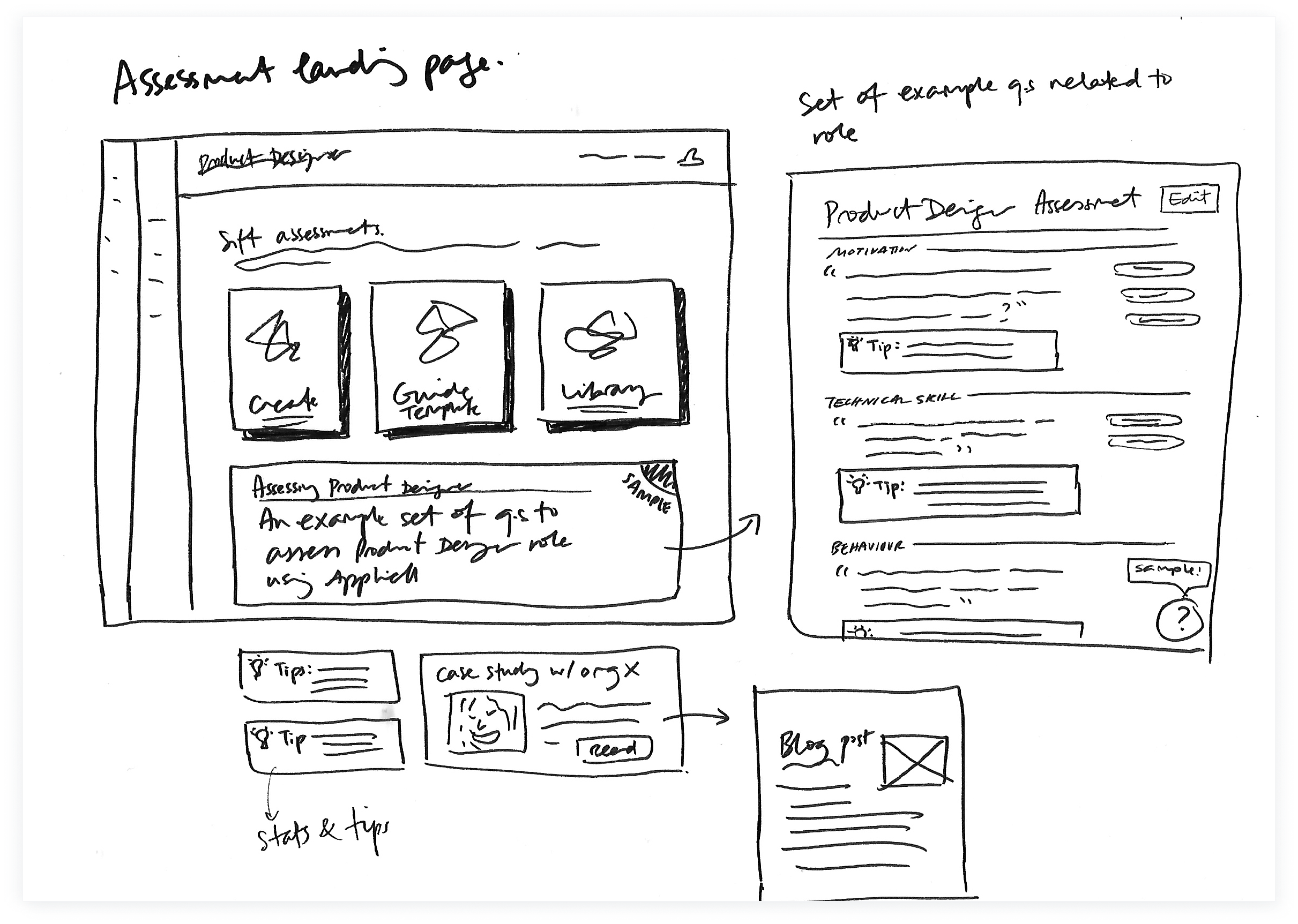
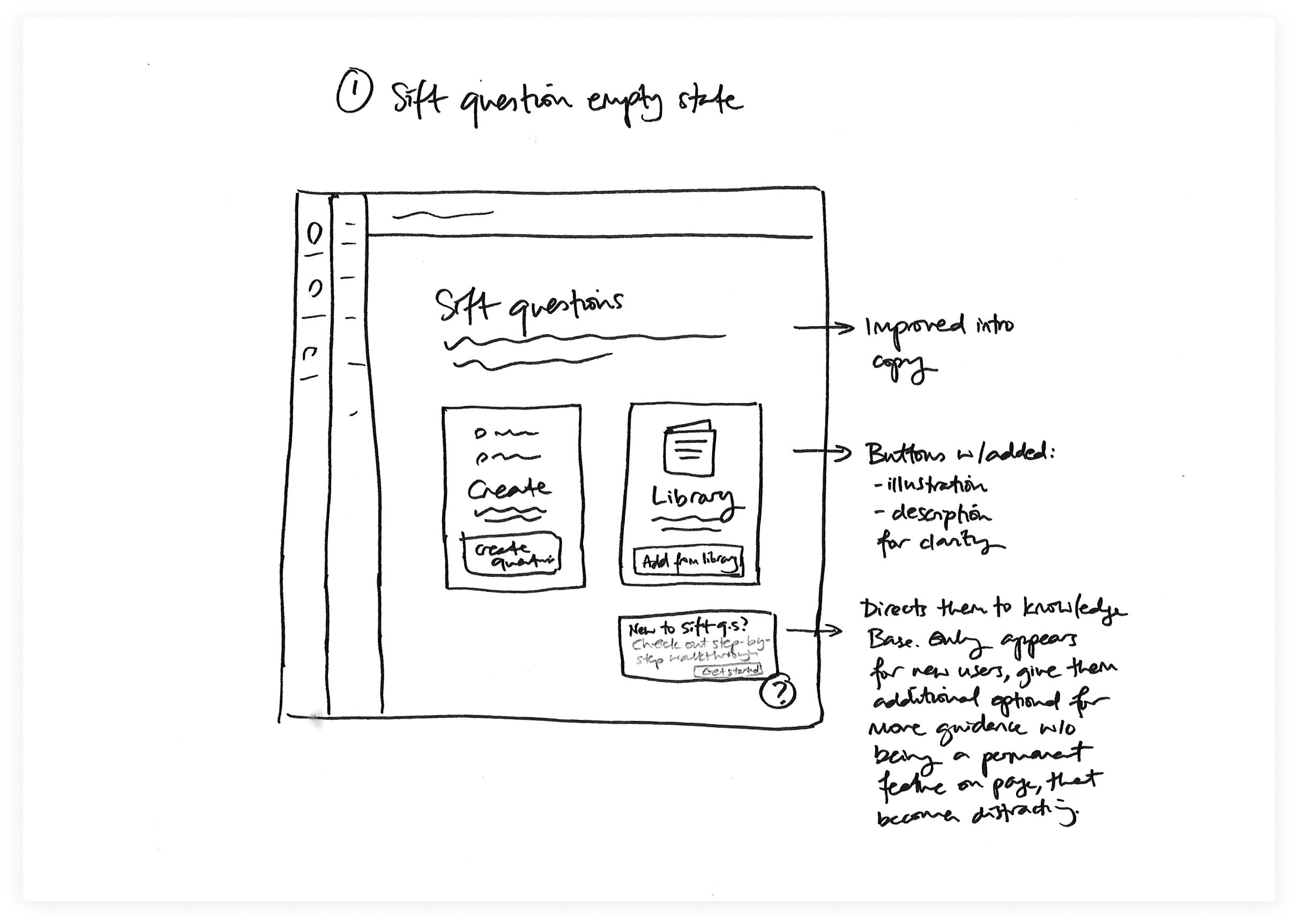
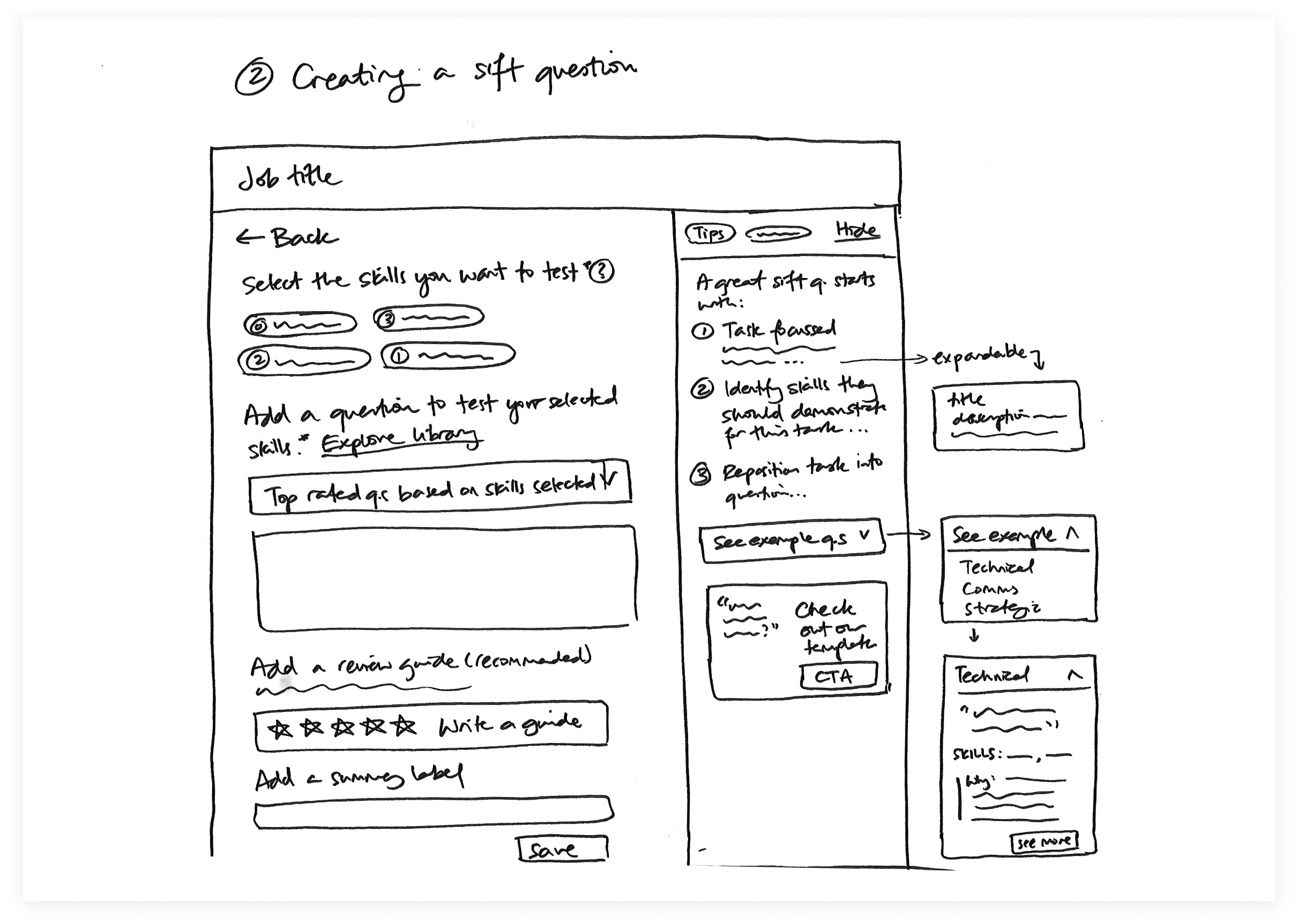
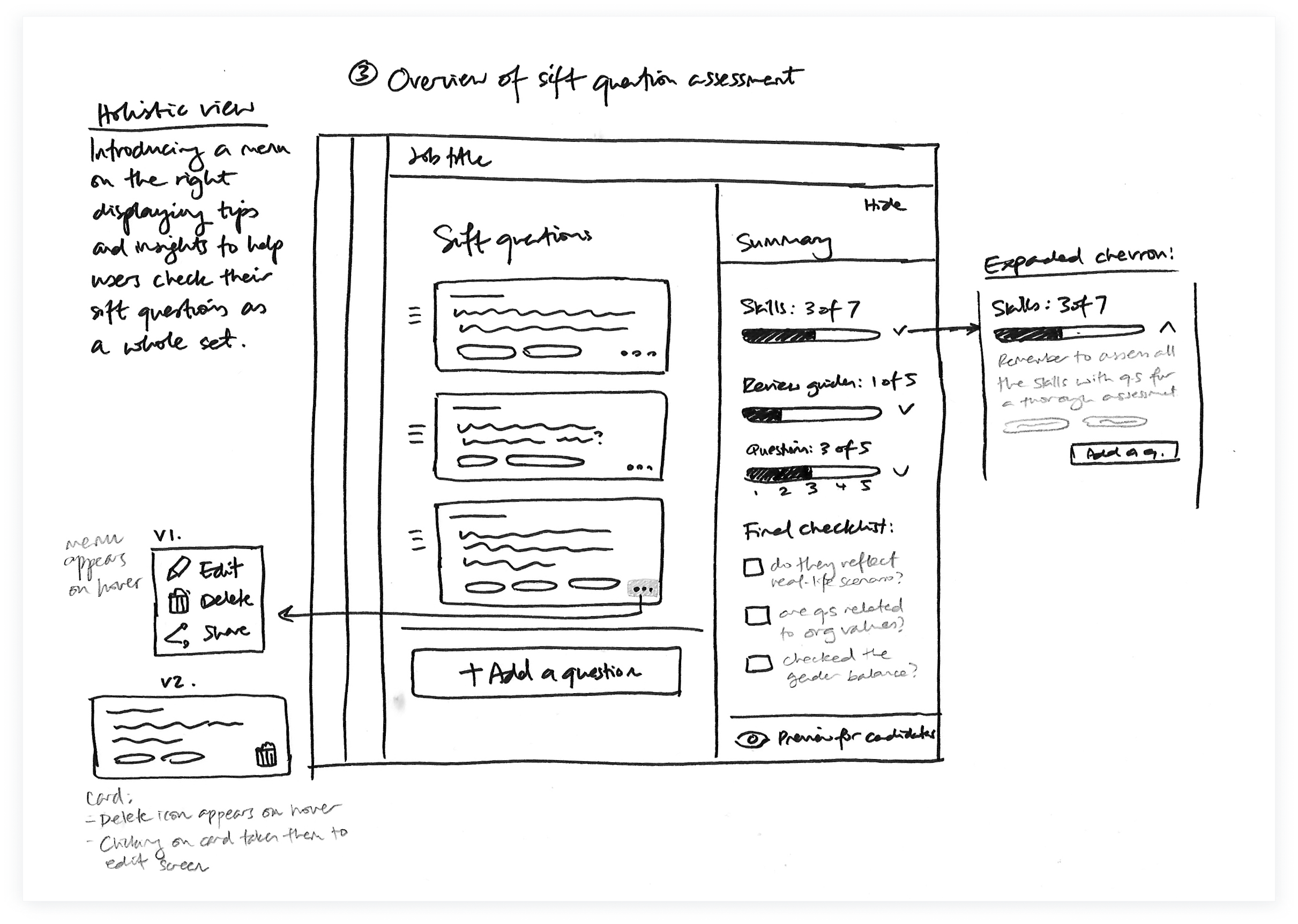
The solution
The solution
The solution
The solution
The solution
Structured assessment standards
Structured assessment standards
Structured assessment standards
Structured assessment standards
- We expanded content in cards based on average word counts in our database, making it easier to review the whole sift assessment together.
- Missing skills or review guides are highlighted with labels, encouraging a complete assessment to aid the entire hiring process.
- Benefits of adding skills and review guides are prominently communicated, new progress bars nudge users to add them.
- We expanded content in cards based on average word counts in our database, making it easier to review the whole sift assessment together.
- Missing skills or review guides are highlighted with labels, encouraging a complete assessment to aid the entire hiring process.
- Benefits of adding skills and review guides are prominently communicated, new progress bars nudge users to add them.
- We expanded content in cards based on average word counts in our database, making it easier to review the whole sift assessment together.
- Missing skills or review guides are highlighted with labels, encouraging a complete assessment to aid the entire hiring process.
- Benefits of adding skills and review guides are prominently communicated, new progress bars nudge users to add them.
- We expanded content in cards based on average word counts in our database, making it easier to review the whole sift assessment together.
- Missing skills or review guides are highlighted with labels, encouraging a complete assessment to aid the entire hiring process.
- Benefits of adding skills and review guides are prominently communicated, new progress bars nudge users to add them.
- We expanded content in cards based on average word counts in our database, making it easier to review the whole sift assessment together.
- Missing skills or review guides are highlighted with labels, encouraging a complete assessment to aid the entire hiring process.
- Benefits of adding skills and review guides are prominently communicated, new progress bars nudge users to add them.

We relocated the primary CTA to match mental models associated with common Trello-like card designs.
We relocated the primary CTA to match mental models associated with common Trello-like card designs.
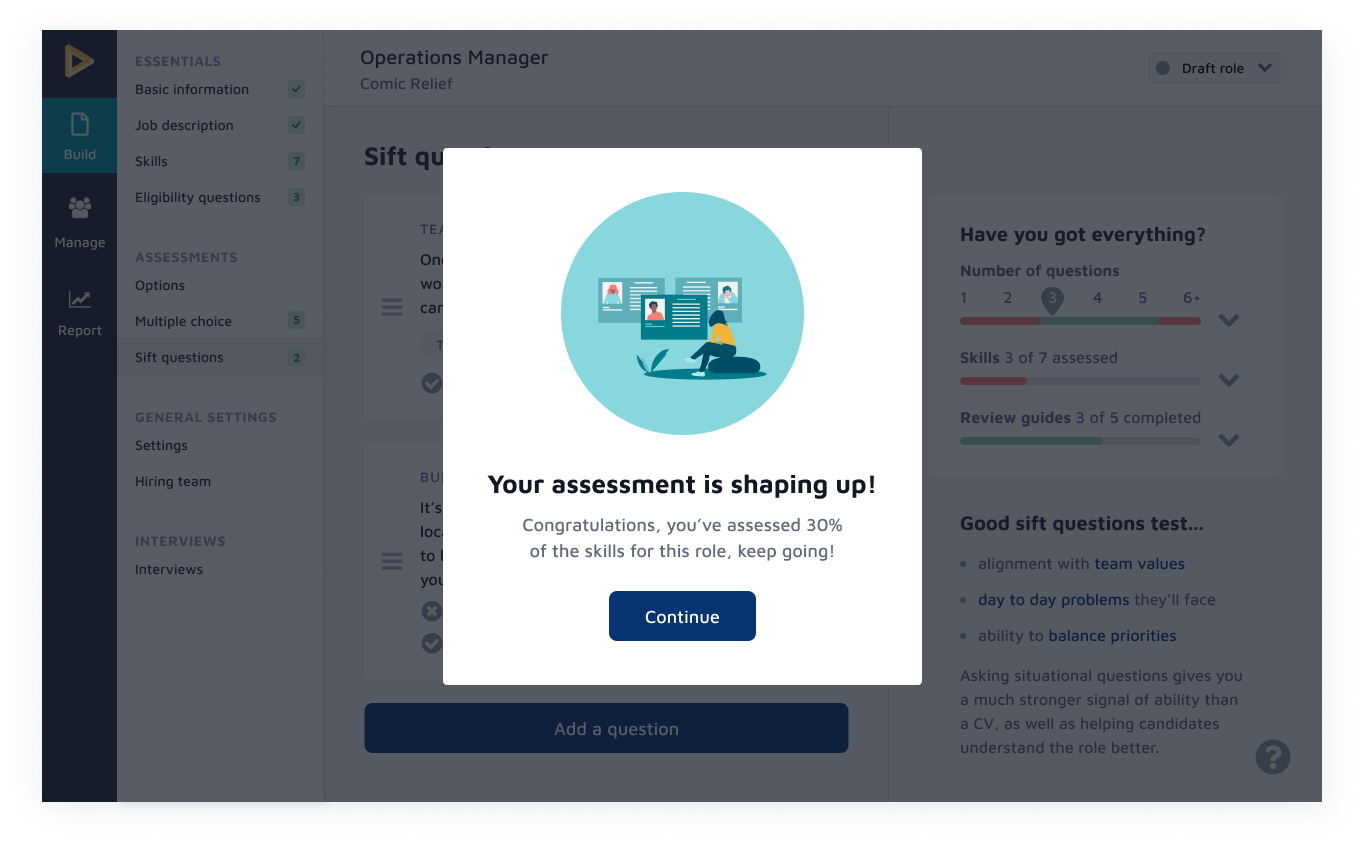
New modals celebrate user milestones, introducing positive nudges towards better assessment practices.
New modals celebrate user milestones, introducing positive nudges towards better assessment practices.
Reduced clutter to focus on the task at hand
Reduced clutter to focus on the task at hand
Reduced clutter to focus on the task at hand
Reduced clutter to focus on the task at hand
- Clear guidance specifies what needs to be done at each stage.
- Inspiration and examples are now only a click away.
- A clear empty state guides users to add missing skills.
- A new order structure helps users focus on the three core tasks first.
- Clear guidance specifies what needs to be done at each stage.
- Inspiration and examples are now only a click away.
- A clear empty state guides users to add missing skills.
- A new order structure helps users focus on the three core tasks first.
- Clear guidance specifies what needs to be done at each stage.
- Inspiration and examples are now only a click away.
- A clear empty state guides users to add missing skills.
- A new order structure helps users focus on the three core tasks first.
- Clear guidance specifies what needs to be done at each stage.
- Inspiration and examples are now only a click away.
- A clear empty state guides users to add missing skills.
- A new order structure helps users focus on the three core tasks first.
- Clear guidance specifies what needs to be done at each stage.
- Inspiration and examples are now only a click away.
- A clear empty state guides users to add missing skills.
- A new order structure helps users focus on the three core tasks first.
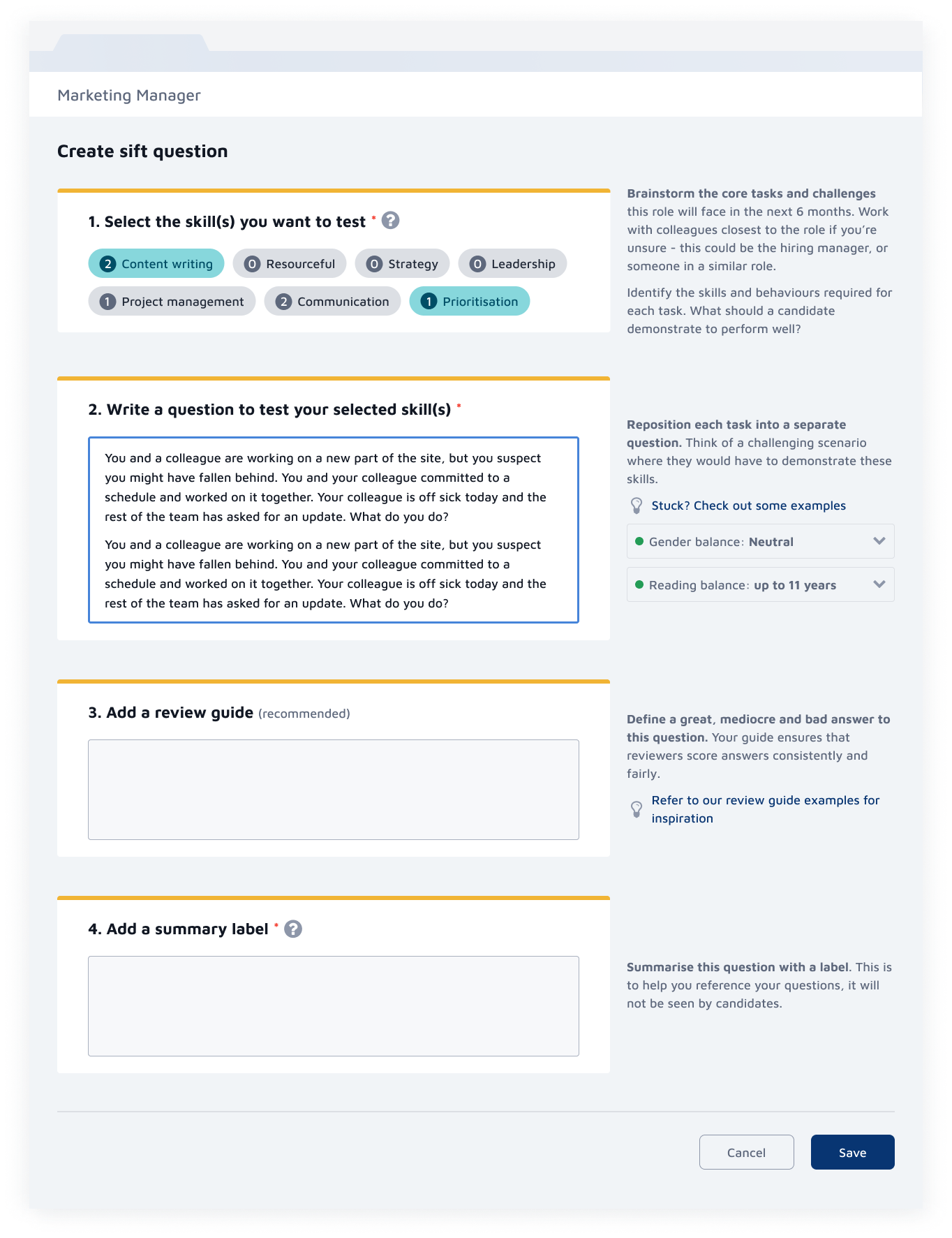
Wireflows and handoffs
Wireflows and handoffs
Wireflows and handoffs
Wireflows and handoffs
Wireflows and handoffs
I created a wireflow to work through all use cases, which supported refinement meetings and Tech handoff.
I created a wireflow to work through all use cases, which supported refinement meetings and Tech handoff.
I created a wireflow to work through all use cases, which supported refinement meetings and Tech handoff.
I created a wireflow to work through all use cases, which supported refinement meetings and Tech handoff.
I created a wireflow to work through all use cases, which supported refinement meetings and Tech handoff.
Timely support
Timely support
Timely support
Timely support
Timely support
I updated the email users received when creating their first role. The previous design had a 0% click rate and linked to resources more relevant to the end of the hiring process. The new design and copy provide more timely resources that match their needs in the hiring journey.
I updated the email users received when creating their first role. The previous design had a 0% click rate and linked to resources more relevant to the end of the hiring process. The new design and copy provide more timely resources that match their needs in the hiring journey.
I updated the email users received when creating their first role. The previous design had a 0% click rate and linked to resources more relevant to the end of the hiring process. The new design and copy provide more timely resources that match their needs in the hiring journey.
I updated the email users received when creating their first role. The previous design had a 0% click rate and linked to resources more relevant to the end of the hiring process. The new design and copy provide more timely resources that match their needs in the hiring journey.
I updated the email users received when creating their first role. The previous design had a 0% click rate and linked to resources more relevant to the end of the hiring process. The new design and copy provide more timely resources that match their needs in the hiring journey.

Support across touchpoints
Support across touchpoints
Support across touchpoints
Support across touchpoints
Support across touchpoints
I created a set of walk-through Google Doc templates to draft sift questions, iterating on an earlier version our Customer Success Manager had created. Our MVP solution now extends support beyond the app, to facilitate better collaboration between Hiring Managers and Job Admins.
I created a set of walk-through Google Doc templates to draft sift questions, iterating on an earlier version our Customer Success Manager had created. Our MVP solution now extends support beyond the app, to facilitate better collaboration between Hiring Managers and Job Admins.
I created a set of walk-through Google Doc templates to draft sift questions, iterating on an earlier version our Customer Success Manager had created. Our MVP solution now extends support beyond the app, to facilitate better collaboration between Hiring Managers and Job Admins.
I created a set of walk-through Google Doc templates to draft sift questions, iterating on an earlier version our Customer Success Manager had created. Our MVP solution now extends support beyond the app, to facilitate better collaboration between Hiring Managers and Job Admins.
I created a set of walk-through Google Doc templates to draft sift questions, iterating on an earlier version our Customer Success Manager had created. Our MVP solution now extends support beyond the app, to facilitate better collaboration between Hiring Managers and Job Admins.
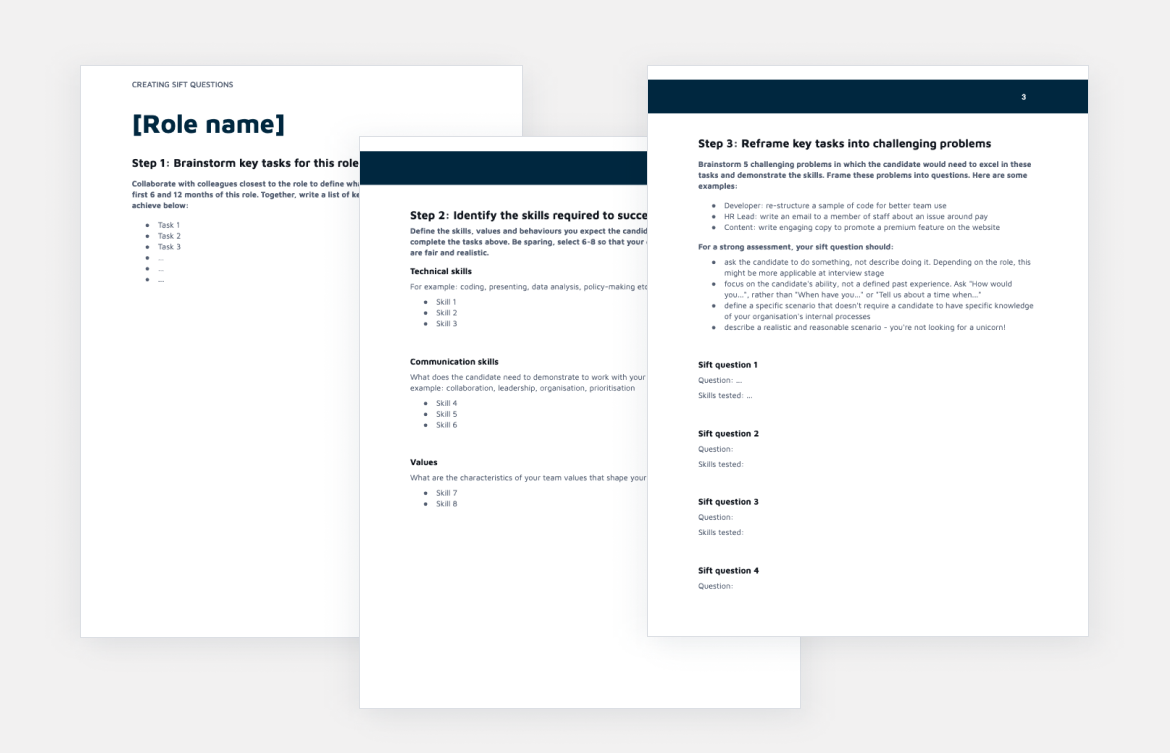
Atomic consistency
Atomic consistency
Atomic consistency
Atomic consistency
Atomic consistency
Alongside the hi-fidelity designs, I documented all components in a Design System to support future consistency and efficient re-use.
Alongside the hi-fidelity designs, I documented all components in a Design System to support future consistency and efficient re-use.
Alongside the hi-fidelity designs, I documented all components in a Design System to support future consistency and efficient re-use.
Alongside the hi-fidelity designs, I documented all components in a Design System to support future consistency and efficient re-use.
Alongside the hi-fidelity designs, I documented all components in a Design System to support future consistency and efficient re-use.
The impact
The impact
The impact
The impact
The impact
We released the new design in May 2020, we're still awaiting more data to track the impact of our metrics, but initial results positively contribute to our north star metric.
We released the new design in May 2020, we're still awaiting more data to track the impact of our metrics, but initial results positively contribute to our north star metric.
We released the new design in May 2020, we're still awaiting more data to track the impact of our metrics, but initial results positively contribute to our north star metric.
We released the new design in May 2020, we're still awaiting more data to track the impact of our metrics, but initial results positively contribute to our north star metric.
6-12% increase in roles using sift questions that follow better assessment practices, contributing to our north star metric of making hiring fairer for all.
6-12% increase in roles using sift questions that follow better assessment practices, contributing to our north star metric of making hiring fairer for all.
6-12% increase in roles using sift questions that follow better assessment practices, contributing to our north star metric of making hiring fairer for all.
6-12% increase in roles using sift questions that follow better assessment practices, contributing to our north star metric of making hiring fairer for all.
6-12% increase in roles using sift questions that follow better assessment practices, contributing to our north star metric of making hiring fairer for all.
View more projects
View more projects
View more projects
View more projects
View more projects
